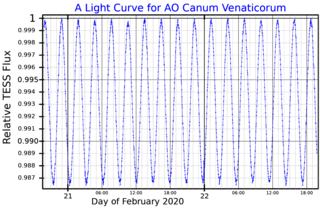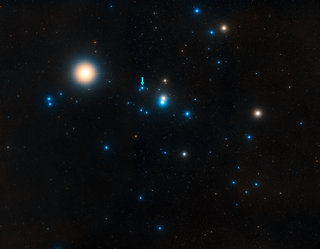Related Research Articles
Upsilon Serpentis, Latinized from υ Serpentis, is a star in the Serpens Caput section of the constellation Serpens. Based upon an annual parallax shift of 13.04 mas as seen from Earth, it is located around 250 light years from the Sun. The star is bright enough to be faintly visible to the naked eye, having an apparent visual magnitude of +5.70. It is a member of the Hyades group, a stream of stars that share a similar trajectory to the Hyades cluster.

20 Canum Venaticorum is a single variable star in the northern constellation of Canes Venatici, located 238 light years from the Sun. This object has the variable star designation AO Canum Venaticorum; 20 Canum Venaticorum is the Flamsteed designation. It is visible to the naked eye as a faint, white-hued star with a baseline apparent visual magnitude of +4.72. The star is moving further from the Earth with a heliocentric radial velocity of +9 km/s. Eggen (1971) listed this star as a member of the Hyades Stream.
HD 81101 is a single star in the southern constellation of Carina. It has the Bayer designation k Carinae, while HD 81101 is the star's designation in the Henry Draper catalogue. The star has a yellow hue and is faintly visible to the naked eye with an apparent visual magnitude of 4.79. It is located at a distance of approximately 225 light years from the Sun based on parallax. This object is drifting further away with a radial velocity of +51 km/s, having come to within 22 light-years of the Sun some 1.4 million years ago.
C3 Centauri is a suspected astrometric binary star system in the southern constellation of Centaurus. It has an orange hue and is dimly visible to the naked eye with an apparent visual magnitude of +5.46. The distance to this object is approximately 342 light years based on parallax. It is a member of the Hyades Stream of co-moving stars.
F Centauri is a suspected astrometric binary star system in the southern constellation of Centaurus. It has a reddish hue and is visible to the naked eye with an apparent visual magnitude that fluctuates around +5.01. The system is located at a distance of approximately 450 light years from the Sun based on parallax, and it has an absolute magnitude of −0.87. O. J. Eggen flagged this star as a member of the Hyades Supercluster.
HD 222093 is a double star in the equatorial constellation of Aquarius. It has an orange hue and is visible to the naked eye with an apparent visual magnitude of 5.68. The system is located at a distance of approximately 293 light years from the Sun based on parallax, but is drifting closer with a radial velocity of −13 km/s.
HD 30442 is a solitary star in the northern circumpolar constellation Camelopardalis. It is faintly visible to the naked eye with an apparent magnitude of 5.47 and is estimated to be 403 light years away from the Solar System. The object has a heliocentric radial velocity of −37 km/s, indicating that it is drifting closer.
HD 56618 is a single star in the southern constellation of Canis Major. It is a red-hued star that is faintly visible to the naked eye with an apparent visual magnitude of 4.66. This object is located at a distance of approximately 390 light years from the Sun based on parallax measurements. It is drifting further away with a radial velocity of +41.5 km/s, having come to within 203 light-years some 2.2 million years ago. Olin J. Eggen listed it as a probable member of the Hyades supercluster.
26 Hydrae is a binary star system located 334 light years away from the Sun in the equatorial constellation of Hydra. It is visible to the naked eye as a faint, yellow-hued point of light with a combined apparent visual magnitude of 4.77, just a few degrees away from Alphard. The system is moving closer to the Earth with a leisurely radial velocity of -1 km/s.
HD 85951, formally named Felis, is a solitary orange hued star in the constellation Hydra. It has an apparent magnitude of 4.94, making it faintly visible to the naked eye under ideal conditions. Based on parallax measurements, the object is about 570 light-years away from the Sun and is receding with a heliocentric radial velocity of 50 km/s.

HD 28527 is a star in the constellation Taurus, and a member of the Hyades open cluster. It is faintly visible to the naked eye with an apparent visual magnitude of 4.78. The distance to this star, as determined from its parallax shift of 22 mas, is 148 light years. It is moving away from the Earth with a heliocentric radial velocity of +38 km/s.
89 Virginis is a single star in the zodiac constellation of Virgo, located 234 light years from the Sun. It is visible to the naked eye as a dim, orange-hued star with an apparent visual magnitude of 4.959. The star is moving closer to the Earth with a heliocentric radial velocity of −39 km/s.
8 Persei is a single star in the northern constellation of Perseus, located 416 light years away from the Sun. It is visible to the naked eye as a dim, orange-hued star with an apparent visual magnitude of 5.757. There is an estimated 52% chance that the star may be a member of the Hyades–Pleiades stream of co-moving stars.
56 Cygni is a single star in the northern constellation of Cygnus, located 135 light years from Earth. It is visible to the naked eye as a white-hued star with an apparent visual magnitude of 5.06. The star is moving closer to the Earth with a heliocentric radial velocity of −21.5. It has a relatively high proper motion, traversing the celestial sphere at an angular rate of 0.181″/yr. According to Eggen (1998), this is a member of the Hyades Supercluster.
77 Ceti is a single, orange-hued star located 489 light years away in the equatorial constellation of Cetus. It is faintly visible to the naked eye, having an apparent visual magnitude of 5.7. This is an evolved giant star with a stellar classification of K2 III. It is radiating 187 times the Sun's luminosity from its photosphere at an effective temperature of 4,206 K.
HR 4699 is a single star in the southern constellation of Corvus. It is orange in hue and is dimly visible to the naked eye with an apparent visual magnitude of +5.14. This star is located at a distance of approximately 201 light years from the Sun based on parallax. It is drifting further away with a radial velocity of +14 km/s, after come to within 45.1 light-years some four million years ago.
HR 2131 is a solitary star in the southern constellation Columba. It has an apparent magnitude of 5.52, allowing it to be faintly seen with the naked eye. The object is located at a distance of 670 light years but is receding with a heliocentric radial velocity of 19 km/s.
HD 200044 is a solitary star in the equatorial constellation Delphinus. It has an apparent magnitude of 5.7, allowing it to be faintly seen with the naked eye. The object is located 598 light years away, but is approaching the Solar System with a heliocentric radial velocity of −15.07 km/s.
HD 46815 is a solitary star in the southern constellation Columba. It is faintly visible to the naked eye with an apparent magnitude of 5.4 and is estimated to be 408 light years away. However, it is receding with a heliocentric radial velocity of 32.2 km/s.
HD 1032 is a solitary star in the southern circumpolar constellation Octans. It is faintly visible to the naked eye with an apparent magnitude of 5.77 and is estimated to be 850 light years away from the Solar System based on parallax measure. However, it is receding with a heliocentric radial velocity of 4 km/s.
References
- 1 2 3 4 5 6 Van Leeuwen, F. (2007), "Validation of the new Hipparcos reduction", Astronomy and Astrophysics, 474 (2): 653–664, arXiv: 0708.1752 , Bibcode:2007A&A...474..653V, doi:10.1051/0004-6361:20078357, S2CID 18759600.
- 1 2 3 4 Anderson, E.; Francis, Ch. (2012), "XHIP: An extended hipparcos compilation", Astronomy Letters, 38 (5): 331, arXiv: 1108.4971 , Bibcode:2012AstL...38..331A, doi:10.1134/S1063773712050015, S2CID 119257644.
- 1 2 Houk, N. (1978), Michigan catalogue of two-dimensional spectral types for the HD stars, vol. 2, Dept. of Astronomy, University of Michigan, Bibcode:1978mcts.book.....H.
- 1 2 Cohen, Martin; et al. (April 1999), "Spectral Irradiance Calibration in the Infrared. X. A Self-Consistent Radiometric All-Sky Network of Absolutely Calibrated Stellar Spectra", The Astronomical Journal, 117 (4): 1864–1889, Bibcode:1999AJ....117.1864C, doi: 10.1086/300813 .
- 1 2 3 Park, Sunkyung; et al. (2013), "Wilson-Bappu Effect: Extended to Surface Gravity", The Astronomical Journal, 146 (4): 73, arXiv: 1307.0592 , Bibcode:2013AJ....146...73P, doi:10.1088/0004-6256/146/4/73, S2CID 119187733.
- 1 2 3 4 5 6 Luck, R. Earle (September 2015), "Abundances in the Local Region. I. G and K Giants", The Astronomical Journal, 150 (3): 23, arXiv: 1507.01466 , Bibcode:2015AJ....150...88L, doi:10.1088/0004-6256/150/3/88, S2CID 118505114, 88.
- 1 2 3 4 Brown, A. G. A.; et al. (Gaia collaboration) (August 2018). "Gaia Data Release 2: Summary of the contents and survey properties". Astronomy & Astrophysics . 616. A1. arXiv: 1804.09365 . Bibcode: 2018A&A...616A...1G . doi: 10.1051/0004-6361/201833051 . Gaia DR2 record for this source at VizieR.
- ↑ "HD 110458". SIMBAD . Centre de données astronomiques de Strasbourg . Retrieved 2021-01-28.
- ↑ Eggleton, P. P.; Tokovinin, A. A. (September 2008), "A catalogue of multiplicity among bright stellar systems", Monthly Notices of the Royal Astronomical Society , 389 (2): 869–879, arXiv: 0806.2878 , Bibcode:2008MNRAS.389..869E, doi:10.1111/j.1365-2966.2008.13596.x, S2CID 14878976.
- ↑ Eggen, O. J. (June 1972), "The red giants in the Hyades group", Publications of the Astronomical Society of the Pacific, 84: 406, Bibcode:1972PASP...84..406E, doi: 10.1086/129303 .